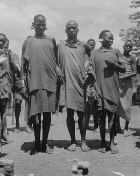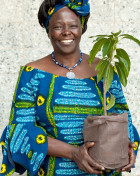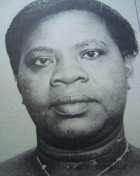Huda Sha’rawi, an activist for women’s rights and social change, is a household name in the Arab world. In many ways, Sha’rawi represented the face of Egyptian feminism, as demonstrated by her actions, thoughts, speeches and writings.
Sha’rawi was born in Minya in 1879 to Muhammad Sultan. She was taught to read the Quran and tutored in Arabic, Persian, Turkish and Islamic subjects by Muslim women tutors in Cairo. She wrote poetry in both Arabic and French. Against her will, she was married to her cousin, Ali Sha’rawi.[1] As a young woman, she showed early signs of her independent spirit by entering a department store in Alexandria to buy her clothes instead of having them brought to her house.[2]
Sha’rawi’s early years of activism started with her establishing Mubarrat Muhammad Ali, a women’s social service organization in 1909, and organizing the Union of Educated Egyptian Women in 1914, the year in which she travelled to Europe for the first time. She worked across class lines to demonstrate against British occupation of Egypt and to lead the Wafdist Women’s Central Committee (WWCC). Sha’rawi often worked within the social confines of her time even as she sought to transform Egypt socially and politically.[3] In 1919, she helped lead the first women’s street demonstration, the ‘March of Veiled Women’, in Cairo to protest British colonial rule and to foil ‘a British plan to exile four Egyptian nationalist leaders, including [her] husband.’[4]
Egyptian feminist discourse and activism during the period of post-colonial state formation and even up to the first half of the 20th century have repeatedly been identified with Huda Sha’rawi, but it is important to note that her activism built on the efforts of women before her.[5] Her narrative texts present the story of her coming into feminism as a natural growth, not as a radical break with the past or with tradition.
In 1923, Sha’rawi founded and became the first president of the Egyptian Feminist Union (EFU)— it is important to note that there is no direct translation in Arabic for the term feminist hence the EFU women used the French term, feministe, French being the language of the upper class.[6] The EFU launched one of the first feminist journals in the French language, L’Egyptienne, in 1925 and its Arabic edition, al-Misriyya, in 1927.
One of the factors that accelerated the growth of the EFU was the relationship its members established with other women through journeys and conferences. For example, after attending an international feminist meeting in Rome in 1923, Sha’rawi cast aside her veil in a very public act. At that moment, she stood between two halves of her life—one conducted within the conventions of the harem system and the one she would lead at the head of a women’s movement.[7]
The hijab, the head covering worn by many Muslim women, was a loaded symbol of the ideological conflicts over culture and collective identity in the Arab World from the late colonial to post-colonial periods. Both its proponents and attackers tended to assign an absolute and essential meaning to the hijab, as good or evil. Neither group considered the possibility that the hijab could be both or neither, or that its meanings shifted with its historical context.
Sha’rawi, in her then radical act of ‘unveiling’, was merely removing the facial screen she used to wear, the curtain behind which the upper-class household secluded its women. By removing the veil, she was dislodging a symbolic barrier impeding women’s access to public life. She noted that by donning the hijab in the first place, she had grounded herself in Islam and Arabic culture, and therefore could claim the right to interpret that culture anew with authority and legitimacy.
After Egypt gained nominal independence from Britain in 1922, Sha’rawi carried on her fight for women’s rights. She led pickets of Egyptian women at the opening of Parliament in January 1924 and submitted a list of nationalist and feminist demands, which were ignored by the then Wafdist (national liberal) government. A member of the Wafdist Women’s Central Committee, she resigned out of frustration with its members’ conciliatory stance toward the Wafd, which could do little about the de facto British control over the country.[8]
Sha’rawi negotiated maximum dividends from her upper-class status and her alliance with men who shared her particular intersection of class, ideological and political interests, for the benefit of the feminist nationalism/nationalist feminism she espoused. Despite these men’s initial discomfort with the notion of the ‘liberation of woman’ (as it was defined by men in that era), it fit to a certain degree with their image of themselves as ‘civilized’ people modelling themselves after ‘the civilized nations.’[9]
The language of the agenda submitted by the Sha’rawi-led EFU to the government reiterates the reasoning that its feminist programme was needed, not because of its inherent rightness, but because Egypt needed ‘to reach a level of glory and might like that reached by the civilized nations.’ That such an agenda was validated by the ‘spirit of religion’, as they add, was a secondary justification for their arguments. This was an understandable strategy, given the need to find common ground on which Copts and Muslims, men and women, could build an Egyptian nation-state.[10]
Sha’rawi continued to lead the national feminist movement and extended the fight to other Arab countries. In 1945, two years before her death at 68, Sha’rawi received the highest decoration from the Egyptian state, the Nishan al-Kamal, for services rendered to the country. Yet, even as the state recognized her for her dual struggles for gender equality and national liberation, ‘it withheld from her political rights. It was a symbol of the contradictions with which she and other women had to live.’[11]
Legacy
While there are controversies about the nature of the feminist voice represented by Sha’rawi, scholars have cautioned that to understand her feminism and activism, one must consider their context of anti-colonial and anti-imperialist struggle. As such, we can see that Sha’rawi did not abandon Islam but was acting within and reacting against a complex web of considerations. Among other tensions she had to negotiate was the accusation that the feminist movement was Westernised and therefore inauthentic. Further contentions have also centred around Sha’rawi’s leadership and portrayal of women, and her early assumption that the experience of a very small category of privileged women could represent and speak on behalf of Egyptian women.
Sha’rawi continued to lead the EFU until her death in 1974, still publishing the feminist journal and representing Egypt at women’s congresses in Graz, Paris, Amsterdam, Berlin, Marseille, Istanbul, Brussels, Budapest, Copenhagen, Interlaken and Geneva. She was instrumental in 1944 in convening the first Arab Feminist Union, which called for solidarity with the Arabs of Palestine. She also proposed the internationalization of the Suez Canal and, shortly before her death, the abolition of nuclear weapons. Even if only some of her demands were met during her lifetime, she laid the groundwork for later gains by Egyptian women and remains the symbolic standard bearer for their liberation movement.
Sha’rawi is seen as a key contributor to the modern Egyptian nation-state. Her contribution to Arab feminisms has many conflicting faces. Nevertheless, her role and leadership have to be acknowledged as complex, contradictory, pioneering and invaluable. She is remembered today as one of the most prominent Arab feminists. She saw the national struggle for independence in Egypt and the struggle for women’s emancipation as inseparable and interdependent.
—
Footnotes:
[2] Ibid.
[3] Sullivan, D.J. & Abed-Kotob, S. (1999). Islam in contemporary Egypt: Civil society vs. the state. Boulder, CO: Lynne Rienner.
[4] Ibid.
[5] Kramarae, C. & Spender, D. (Eds.). (2000). Routledge international encyclopedia of women (Vol. 2): Global women’s issues and knowledge. New York, NY: Taylor and Francis.
[6] Kramarae, C. & Spender, D. (Eds.). (2000). Routledge international encyclopedia of women (Vol. 2).
[7] Sullivan, D.J. & Abed-Kotob, S. (1999). Islam in contemporary Egypt.
[8] Goldschmidt, A. (1999). Biographical dictionary.
[9] Kahf, M. (1988). Huda Sha’rawi’s ‘mudhakkirati.’
[10] Ibid.
[11] Ibid.





